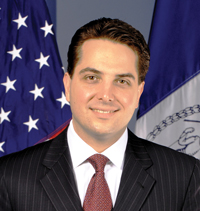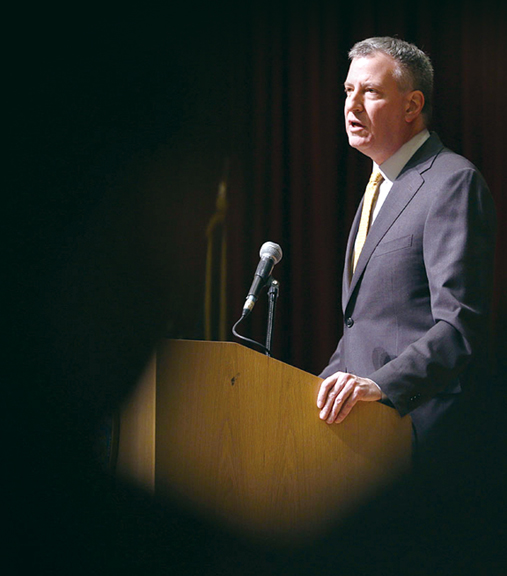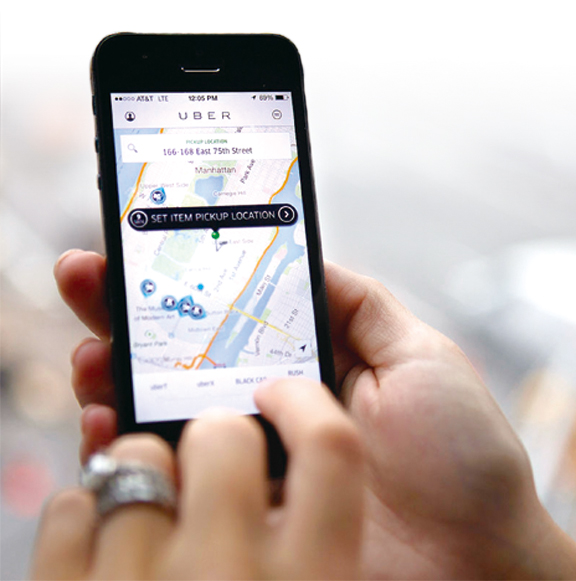 |
IN FOCUS |
|
by Matthew W. Daus, Esq. |
||
New York City (NYC) has always been a bellwether for for-hire transportation regulatory best practices around the world. Based upon recent escapades by Uber, the situation in NYC is somewhat comparable to the Iowa caucus and New Hampshire primary in U.S. Presidential elections, or maybe the recent political disruption caused by the entry of Donald Trump into the race.
The grass roots campaigning and media, political and lobbying approach taken by Uber, has been highly effective in many ways. While many supporters welcome it, just as many critics find it reprehensible or unethical. "Is it democracy or a disruption of democracy?", is the true question. Perhaps, "to Cap or not to Cap", is the more direct regulatory question to ask as Mayor Bill de Blasio and the NYC Council attempt to hit a pause button on the unprecedented growth of the open licensing system for for-hire vehicles, including Uber.

The July 2015 FHV Cap issue in NYC played out just like a soliloquy with all the makings of a William Shakespeare play. Recent events on the political and media stage were reminiscent of the nunnery scene in Hamlet where a troubled Prince Hamlet poses the rhetorical question --"to be or not to be?"
Hamlet did so while contemplating his life and the unfairness of life, but then realizes the alternative is far worse as he decides to avenge his father's death upon his uncle, stepfather and King Claudius. The recent political theatre in NYC was like a summer version of "Shakespeare in the Park!", complete with dueling press conferences, political mayhem and revenge, shifting and redefined industry and political coalitions, and Mayor de Blasio taking center stage.
As our Prince Hamlet, with plummeting polls and criticisms being leveled everywhere at him, 1 Mayor de Blasio held firm in his resolve to level the regulatory playing field by helping to alleviate traffic congestion and improve the environment. Then along came a NY State Governor, Andrew Cuomo, who was recently criticized by the Mayor for supposedly calculating the defeat of many other Mayoral proposed state legislative initiatives.
Allegedly, on behalf of Uber, the Governor called the NYC Council Speaker, Melissa Mark-Viverito, a de Blasio ally, to convince her to not hold a vote on the FHV Cap legislation 2 pending a study to be conducted to determine the next steps on the growth of the industry. Then, there was a so-called negotiation that the Council and the Mayoral Administration both claimed to hold with Uber where, in exchange for a temporary reprieve on the cap to conduct a study, Uber will now need to turn over its data to NYC and its Taxi and Limousine Commission (TLC). 3

THE BEGINNING OF THE FHV SAGA
The FHV Cap saga started when the New York City Council ("Council") held a hearing on June 30th regarding two bills affecting Uber. The bills were introduced at the Council a few days before this hearing.
There was no doubt about the importance of this legislation to Mayor De Blasio because his office sent two commissioners and the Director of his Office of Sustainability to testify in support of the bills. 6 The panel testified about why a study was needed to examine the increase in traffic and pollution as a result of the addition of thousands of new for-hire vehicles. It also testified that a cap was needed to keep variables constant.
Uber's testimony framed the proposed cap as a job destroyer. The company testified that a cap would immediately cause 700 drivers to lose their jobs and eliminate another 10,000 jobs they were planning to add in the next year. 7
Uber also questioned the motives for the study and said that the methodology was flawed and biased. A panel of technology and business advocacy groups testified against the bills stating that they would harm small businesses and stifle innovation. A few companies that lease vehicles to the for-hire vehicle industry also testified against the bills citing the potential negative effects on their businesses.
A panel of disability advocates testified in support of the bills stating that for-hire vehicles do not have the same accessibility requirements as taxis and that their explosive growth threatened the City's mandate to require half of all taxicabs become accessible by 2020. Taxicab industry advocates also testified in support of the bills citing the negative effect of uncontrolled growth on taxi driver income.
The Council was expected to vote on both bills on July 23rd. However, on late on July 22nd, the Mayor announced that there would be no cap. 8 Instead, the Council just voted to require the study, which was to be completed by April 1, 2016 according to the bill, to be completed instead by December 1, 2015 according to Council Speaker Melissa Mark-Viverito. 9
The decision to drop the cap came after Uber conducted a multi-million dollar campaign against the Mayor and Council Members with mailers, television ads and the recruitment of allies in the minority community. 10
The bill requires the TLC, in collaboration with other relevant City agencies, to complete a study on the impact of the growth of the taxicab, street hail livery, livery, black car and luxury limousine industries. Among the impacts that the study will focus on are traffic, air quality, noise and public health. Among some of the factors to be considered are:
The Mayor signed this bill into law on August 10, 2015, and it will take effect immediately. 11
The bill placed a cap on for-hire vehicle licenses. It was not enacted. The cap would have slowed the growth of for-hire bases with 500 or more affiliated cars to no more than 1% for newly licensed vehicles. Those bases with 499 to 20 affiliated vehicles would be allowed to add 5% more newly licensed vehicles, and those bases with less than 20 affiliated vehicles could add only an additional 15% of newly licensed vehicles. This temporary cap would have been in effect until April 30, 2016. 12
The recent political, lobbying and media showdown that took place at the end of July 2015 in NYC between the Mayor, the Governor and the NYC Council made national and international news, and developed into a major public spectacle. This "spectacle" included:
This type of media circus has not been seen in NYC since the showdown between former Mayor Michael R. Bloomberg and the owners of Madison Square Garden on the failed New York Jets' West Side football stadium proposal several years ago.
Certainly, the debate and the fight are far from over. There is still a major environmental and traffic study that may ultimately propose a cap or limitation on for-hire vehicle growth in NYC, with possible exemptions for ride-sharing, wheelchair accessible vehicles and alternative fueled vehicles as mitigating factors.
Most cities around the country do not technically impose absolute caps on the number of taxicabs, and actually have a legal standard for growth, as well as a process for transportation companies to apply for and receive new permits. These review standards typically require analysis of vehicle supply and passenger demand, traffic congestion and environmental issues. It is very possible that new legislation may put such standards into place to allow for "checked" instead of "unchecked" growth.
The political face saving, retribution, personalities, political supporters and stakeholders will all be mobilizing once again after December 2015 or early in January 2016. This will occur after the report is issued because the report is likely to be a blueprint for proposed legislation by the NYC Mayor's Office and the Council. It is also possible that Uber may lobby the Governor and the State Legislature intensely to pass a state law preempting any such new laws proposing a cap, moratorium or "growth-check" process for for-hire vehicles.

CAR SERVICE IMPACT STUDY AND DATA COLLECTION TO GUIDE FUTURE TNC LEGISLATION
On other issues, the TLC regulations and the data that may be collected under the alleged "Uber deal" to table the legislation, will become part of the study. The TLC will obtain a much better picture of the economic impact Uber is really having on its competitors, traffic and the environment. It is very possible that the "surge" pricing bill 13, capping fares to no more than double the normal range of fares, could be resuscitated at the local level.
Insurance legislation 14 creating Transportation Network Company (TNC) group insurance polices, making it easier for TNCs to operate in New York State and possibly NYC, could receive new life with the Governor looking into the issue following the recent "NYC Uber Spectacle." Also, there are pending lawsuits from the industry that could cause the entire focus to shift. Both the incumbent industry and Uber could bring additional legal actions following the passage of any new laws as well. 15
The battle is actually just beginning in NYC, but it may have a ripple effect in other states. Similarly, due to insurance, accessibility and criminal background check controversies, Texas, Connecticut and Florida all recently tabled and did not pass new TNC statewide laws.
The attention focused on NYC may not be good for Uber. Legislators, the riding public and the media around the country may now become more aware of the fact that Uber is licensed in NYC just like taxicabs, black cars and liveries. UBER dominates the NYC car service market with more than 18,000 vehicles, and is still fighting to take a greater share by adding thousands of more vehicles.
The millions spent by Uber in NYC may have helped its cause nationally in some ways by over exaggerating Mayor de Blasio's decision as having somehow "caved" to Uber. This Shakespearean Uber spin may set a bad precedent for other elected officials around the country as the message will be: "your poll numbers could drop and you could lose your re-election bid unless you do everything Uber tells you to do."
However, the recent re-election of San Antonio's Mayor, Ivy Taylor, under similar circumstances when she objected to Uber style background checks and other deregulation attempts, disproves that theory. Mayor de Blasio's drop in the polls mid-term are not unusual for sitting Mayors, and former Mayor Bloomberg had even lower poll numbers prior to a resounding re-election victory many years ago. As Hamlet would say, "to sleep, perchance [Uber is] to dream, that is the rub."
Many jurisdictions around the United States (and the world) may follow and replicate what is done in NYC from a transportation regulation standpoint and, despite the unique nature of the NYC market, the recent NYC battle could very well change the debate, direction and the legislative dynamic of what happens in 2016 and beyond around the nation.
The disruption continues like a hydra, and shows no sign yet of settling down. In fact, the Uber issue may continue to be an issue in the 2016 Presidential race and debate as part of worker rights and protections for part time workers in the sharing economy. 16 So far, Hillary Clinton has raised concerns about Uber's labor issues, while Republican candidates Marco Rubio and Jeb Bush had both made favorable comments about the company.
As Mayor de Blasio seeks to regroup while the study proceeds over the next several months, Hamlet's nunnery scene will play out with the Mayor and the Council contemplating the question of whether "to cap or not to cap" :
Whilst Uber, doth thou object to the study's findings?
Will pursuing the cap further be political suicide?
Will the Mayor avenge the death of the cap bill?
Will there be retaliation by and between Uber and between various high level elected officials?
Was criticism that Uber levied the cause of a recent drop in poll approval ratings for the Mayor fair?
Is political life and transportation regulation in the "Big City" fair?
Will city officials find, as Hamlet said, that "Tis nobler in the mind to suffer the slings and arrows of outrageous fortune, or take arms against a sea of troubles, and by opposing end them?"
All of those questions, some being rhetorical, and many more, will play out over the next several months on the political stage with more theatre to follow. This was only the first Act in an unfinished performance.
1 http://www.nytimes.com/2015/08/06/nyregion/mayor-de-blasios-approval-ratings-hit-a-low-point.html?_r=0
2 http://www.capitalnewyork.com/article/city-hall/2015/07/8572594/cuomo-urges-city-council-delay-uber-vote#
3 http://www.crainsnewyork.com/article/20150722/POLITICS/150729934/de-blasio-agrees-to-delay-vote-on-uber-cap
4 http://legistar.council.nyc.gov/LegislationDetail.aspx?ID=2364032&GUID=38613BB6-5A68-416E-9C27-9F43E3C60372&Options=ID|Text|&Search=int+842
5 http://legistar.council.nyc.gov/LegislationDetail.aspx?ID=2364031&GUID=87C7D249-891A-43BC-8127-6617FB856429&Options=ID|Text|&Search=int+847.
6 Commissioner Polly Trottenberg of the New York City Department of Transportation, Commissioner Meera Joshi of the New York City Taxi and Limousine Commission and the Director of the Mayor's Office of Sustainability, Nilda Mesa, testified on behalf of the Mayor.
7 http://nypost.com/2015/07/12/700-uber-drivers-to-be-fired-under-new-bill/
8 http://www.nytimes.com/2015/07/23/nyregion/de-blasio-administration-dropping-plan-for-uber-cap-for-now.html?_r=0
9 http://legistar.council.nyc.gov/LegislationDetail.aspx?ID=2364031&GUID=87C7D249-891A-43BC-8127-6617FB856429&Options=ID|Text|&Search=int+847.
10 http://www.nydailynews.com/new-york/uber-meets-minority-workers-fight-proposed-car-cap-article-1.2292479
11 http://legistar.council.nyc.gov/LegislationDetail.aspx?ID=2364031&GUID=87C7D249-891A-43BC-8127-6617FB856429&Options=ID|Text|&Search=847
12 http://legistar.council.nyc.gov/LegislationDetail.aspx?ID=2364032&GUID=38613BB6-5A68-416E-9C27-9F43E3C60372&Options=ID|Text|&Search=int+842
13 http://legistar.council.nyc.gov/LegislationDetail.aspx?ID=2073899&GUID=0C1C4C28-9D46-4021-BAA6-EAC0D95D5F09&Options=ID|Text|&Search=556
14 http://open.nysenate.gov/legislation/bill/S4108C-2015
15 See http://www.crainsnewyork.com/article/20150527/BLOGS04/150529893/taxi-interests-sue-city-predicting-collapse-of-their-industry and http://www.nydailynews.com/new-york/cabbies-claim-tlc-uber-customers-article-1.2169132.
16 Democratic Presidential Candidate Hillary Clinton recently stated she would crack down on companies that misclassify their workers as independent contractors, which many have interpreted as being directed towards Uber and other sharing economy type companies. Republican candidates were quick to criticize her remarks as anti-innovation. http://www.businessinsider.com/grover-norquist-hillary-clinton-uber-2015-7